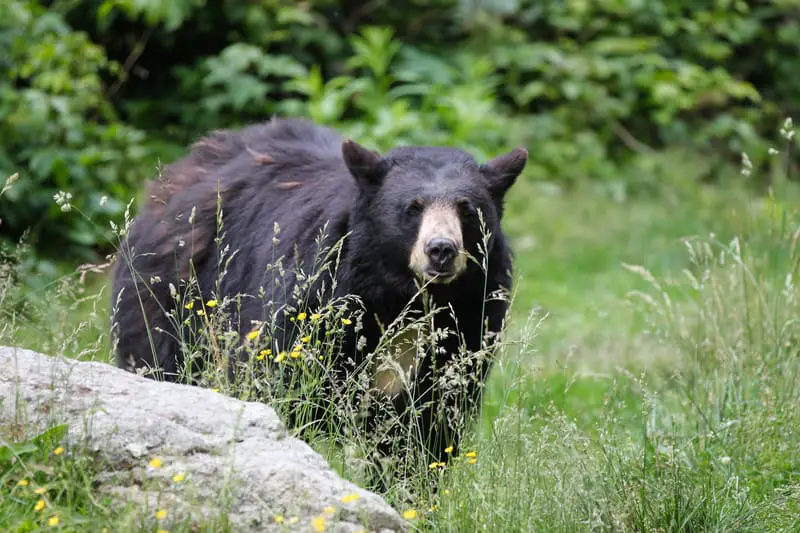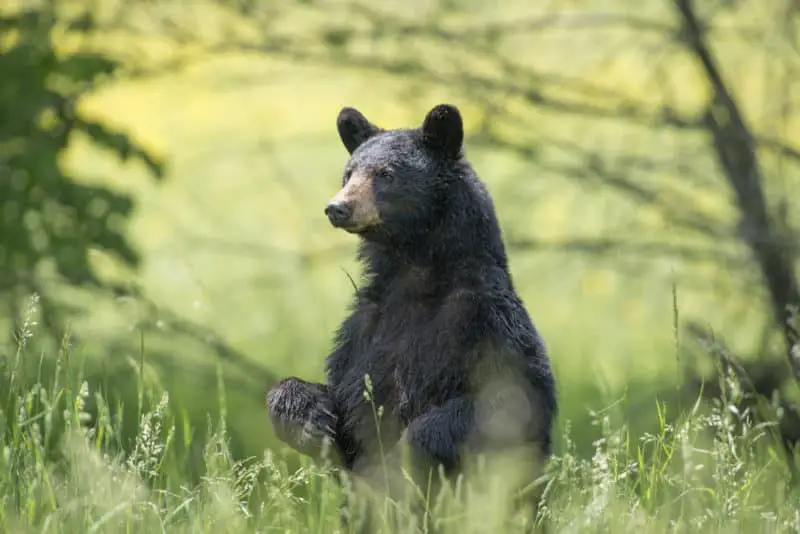Have you ever wondered if there are bears in New York? The answer is yes! In fact, in recent years, with an abundance of natural habitat, the bear population in New York has been on the rise, as it also has in the neighboring states of Pennsylvania and New Jersey. According to the New York State Department of Environmental Conservation, the empire state is home to the American black bear. Right now, the black bear population in the state hovers somewhere between 6000 and 8000 animals.
If you want to see Grizzly bears, polar bears, or brown bears in New York, you’ll have to go to a zoo to find them. On the other hand, black bears are the only species of bear that is native to the state, and their wild population is doing well.
Where do black bears live?
The black bear’s scientific name, Ursus americanus, means American bear in English. They are the most common and well-known bears native to North America. Their range begins in Alaska and northern Canada and extends south into central Mexico. Only 9 of the contiguous U.S. states don’t have breeding black bear populations.
The majority of N.Y. – black bears live in or adjacent to the state’s mountain ranges. 50% to 60% of the state’s bears live in the Adirondack region, while 30% to 35% live in the Catskill mountains and 10% to 15% live in the central-western region of the state. See
There are also bear populations in the Tug Hill, which is in northern New York, west of the Adirondacks, the Hudson Valley, and the Southern Tier, which is the border area that New York shares with Northern Pennsylvania.
Black bears are mostly solitary animals with the exception of raising young. Their home ranges vary in size depending on the density of potential food sources. In New York, a male black bear will have a home range that encompasses 8 to 60 square miles, while a female will have a home range that covers 1 to 15 square miles. While these animals generally do have home ranges and will defend a food source or a mate if another bear is present, they are not overly territorial and will tolerate the presence of other bears within their home ranges.

What do black bears look like?
In New York, black bears are the second largest mammal in the state after the moose. Adult black bears are anywhere from 50 to 85 inches long from the tip of the nose to the tip of the tail. Their average height is around 30 inches at the shoulder.
The normal black bear’s weight range is from 140 to 400 pounds. However, males can be up to 70% larger than female black bears, and some giant-sized individuals weigh over 800 pounds. The heaviest bear ever taken in New York came from Franklin County. It had a dressed weight of 660 pounds and an estimated live weight of 750 pounds.
The heaviest black bear ever harvested came from Pike County, Pennsylvania. It weighed 875 pounds.
Even though they are named black bears, their colors can vary from black, blue-grey, cinnamon, brown, blue-black, and on infrequent occasions, a black bear can even be white. Although most New York bears are black, a small percentage of them are cinnamon colored. Some black bears have a V-shaped white patch on their chest.
They have long brown snouts, short tails, and small brown eyes, although their eyes are blue at birth. Black bears lack the shoulder hump that brown bears or grizzly bears have. In areas that both species inhabit, the hump, or the lack thereof, is a distinguishing feature. Any wild bear in New York will be a black bear, though.
How to make your home less attractive to bears
In drought years, there is a higher likelihood of human-bear conflicts. Bear sightings in rural and even suburban and urban areas increase significantly in times of drought. Drought stressed bears may wander into areas with higher human populations in search of food.
Another factor that can potentially cause bears to wander is the time of year. When female bears or sows begin to kick their previous year’s cubs off, these young bears sometimes wander into residential areas as they search for their own territory.
According to Tom Cunningham, who is a DEC wildlife Technician, Upstate New York has reached a point where it, in its entirety, is bear habitat. See
Besides being dangerous apex predators, bears can potentially cause significant damage to your home and or vehicles. For example, if a black bear smells food in your parked car, it is capable of tearing the door off to get to it.
If you live in bear country, the following tips will make your property less attractive to wandering bears.
Pet food
It’s a bad idea to feed your outside pets more than they can efficiently clean up before dark. It’s also a bad idea to store your pet food outside. If you store your pet food outside, keep it in a bear-proof container.
Barbeque grills
Backyard barbecue grills are bear attractors. You Should clean your barbecue grill after every use and store it inside. If you live on a large property, dispose of your grease drippings and food waste in an area far away from your home. For the majority of people, though, who don’t live on a large acreage, the best thing to do is to store your grease drippings and food waste in the refrigerator until the day of your garbage pickup and then throw it away just before the garbage truck comes. Along this line, you should also store indoors and clean and disinfect your garbage cans regularly.
Vehicles
Keep all food or empty containers that have had food in them out of your vehicles. Bears have a keen sense of smell. Furthermore, as I mentioned earlier, an adult black bear is capable of bending your car door in half if it decides it wants to get inside.
Use electric fencing
If you have a vegetable garden, a chicken coop, fruit trees, or any other outside bear attractants, you should conder using electric fencing to keep the bears at bay.
Bird feeders will attract bears.
Also, bird feeders have the potential to bring bears to your property, whether that be hummingbird feeders or ones that dispense out bird seed. If you live in bear country, it’s not a good idea to put out bird seed except during the winter months when bears will be in hibernation.
Never feed the bears.
A huge mistake that people sometimes make is to put food out to attract bears on purpose. When you do that, you create a situation that is beyond your control.
When bears begin to associate people with food, they lose any fear of humans that they might have had. They also might act out aggressively if they decide that you’re not giving them the food that they want and are accustomed to. They might also take that frustration out on your neighbor or, worse yet, your neighbor’s children. Look at the article found here for an example of what I’m talking about.
The best way to make a wild bear into a nuisance bear is to feed it. From there, the chances increase that it will have to be euthanized because it poses a danger to humans.

How dangerous are black bears?
The knee-jerk response to that question is that black bears are timid creatures; they’re more afraid of you than you are of them. etc… All that is true most of the time.
The following is from the Krebs Creek article titled Are Black Bears Dangerous to Humans?
“Black bears are not aggressive generally. They’re omnivores, which means their diet includes plant material but also meat. At times, Black Bear’s diets have been documented to consist of 96% plant material. This makes them one of the least predacious of all carnivores. However unaggressive they might be most of the time, black bears are still dangerous. In fact, at least one person is killed somewhere in North America each year by a black bear.
From 2001 through 2021, Black Bears killed twenty-eight people in North America. That’s a fact that flies in the face of the other points we know about these animals.
According to Doctor Stephan Herrero in his book “Bear Attacks, Their Causes And Avoidance,” from 1900 through 1980, 90% of the fatal attacks by black bears on humans in the United States and Canada were carried out by a predatory animal. In other words, 90% of the time, when black bears attack people, it’s because they view them as a food source.”
I’ll leave off there; if you want to read the rest of the article, you can click on the link.
The point is not to scare the reader. Black bear attacks are very rare. However, we’re dealing with unpredictable wild animals that have the ability to kill you with very little effort if that’s what they decide to do, and in rare circumstances, that’s exactly what they decide to do. Take that into consideration before you feed one.
Bear hunting in New York
Hunting is the primary method that the NYDEC uses to control and manage bear populations throughout the state.
According to an article I found in the Sullivan County Democrat, in 2021, there were a total of 1346 bears harvested in the state of New York. See
New York State offers almost 3 months of bear hunting opportunities. Below is a partial list of regulations that pertain to the state’s bear hunt.
- In New York, the state is divided into 2 game management zones, a northern zone, and a southern zone.
- There is no bear hunting allowed on Long Island
- Hunting over bait or with dogs is prohibited. However, hunters may carry up to 1 1/2 ounces of liquid scent lure.
- In the southern zone, it is illegal to shoot a bear cub. What’s more, hunters cannot shoot a bear from a group of bears or take a bear from its den.
- Both New Yorkers and non-residents can hunt bears in the state if they are legally licensed
- Legal hunting implements, such as a rifle, bow, etc., vary with the zone and time of year. See the official proclamation for more details.
- Rifles are not legal implements for big game hunting in some counties or parts of counties in the southern zone.
- It’s illegal to hunt with an automatic firearm or a semi-automatic that holds more than 6 shells, with the exception of an autoloading pistol with a barrel that is less than 8 inches long.
- It’s illegal to hunt with a silencer.
This is only a partial list of regulations. Look here and also here for more details.
You might also like
Are There Wild Cats in New York State? – Krebs Creek
Recent Posts
The only venomous snakes in Washington State are Northern Pacific Rattlesnakes. The Northern Pacific Rattlesnake (Crotalus oreganus oreganus) is a sub-species of the Western Rattlesnake. Anyone...
Skunks are not classified as true hibernators. But they go into a state of torpor when the weather gets cold. Skunks are light sleep hibernators, along with opossums, bears, and raccoons. ...

